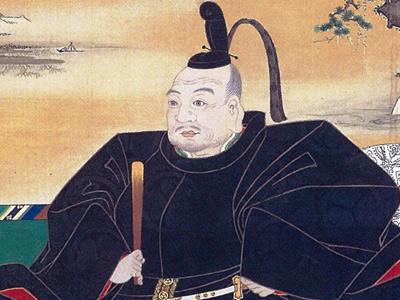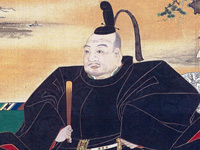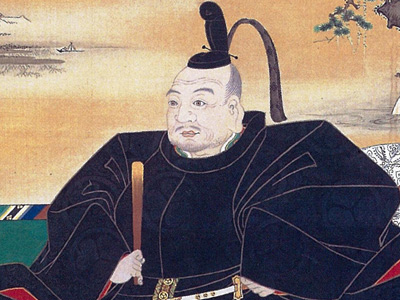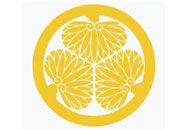Tokugawa Ieyasu (1543-1616)

Rise to Power (1556–1584)
In 1556 he came of age, and, following tradition, changed his name from Matsudaira Takechiyo to Matsudaira Jirōsaburō Motonobu (松平 次郎三郎 元信). One year later, at the age of 13 (according to East Asian age reckoning), he married his first wife, Lady Tsukiyama, and changed his name again to Matsudaira Kurandonosuke Motoyasu (松平 蔵人佐 元康). Allowed to return to his native Mikawa, the Imagawa ordered him to fight the Oda clan in a series of battles.
Motoyasu fought his first battle at the Siege of Terabe. He then succeeded in delivering supplies to an Imagawa Yoshimoto fortress in the 1559 Siege of Odaka.
By 1560 the leadership of the Oda clan had passed to the brilliant leader Oda Nobunaga. Imagawa Yoshimoto, leading a large Imagawa army (perhaps 25,000 strong) attacked the Oda clan territory. Motoyasu, with his Mikawa troops, captured Marune and then spent the night in Odaka. As a result, Motoyasu and his men were not present at the Battle of Okehazama where Yoshimoto was killed by Nobunaga's surprise assault.
Alliance with Oda
With Yoshimoto dead, Motoyasu decided to ally with the Oda clan. A secret deal was needed because Motoyasu's wife, Lady Tsukiyama, and infant son, Nobuyasu, were held hostage in Sunpu by the Imagawa clan.
In 1561, Motoyasu openly broke with the Imagawa and captured the fortress of Kaminogō. Motoyasu was then able to exchange his wife and son for the hostages thus gained. In 1563 Nobuyasu was married to Nobunaga's daughter Tokuhime.
For the next few years Motoyasu set to reform the Matsudaira clan and pacifying Mikawa. He also strengthened his key vassals by awarding them land and castles in Mikawa. They were: Honda Tadakatsu, Ishikawa Kazumasa, Kōriki Kiyonaga, Hattori Hanzō, Sakai Tadatsugu, and Sakakibara Yasumasa.
Motoyasu defeated the military forces of the Ikkō-ikki at the Battle of Azukizaka. The Monto were a warlike group of monks that were ruling Kaga Province and had many temples elsewhere in Japan. They refused to obey Motoyasu's commands and so he went to war with them, defeating their troops and pulling down their temples. In one battle, Motoyasu was nearly killed when he was struck by a bullet which did not penetrate his armour. Both Motoyasu's Mikawa troops and the Monto forces were using the new gunpowder weapons which the Portuguese had introduced to Japan just 20 years earlier.
Growing Political Influence
In 1567, he changed his name yet again, this time to Tokugawa Ieyasu. By so doing, he claimed descent from the Minamoto clan. No proof has actually been found for this alleged descent from Emperor Seiwa. Yet, his family name was changed with the permission of the Imperial Court, after writing a petition, and he was bestowed the title Mikawa-no-kami and the court rank of Jugoige.
Ieyasu remained an ally of Nobunaga and his Mikawa soldiers were part of Nobunaga's army which captured Kyoto in 1568. At the same time Ieyasu was expanding his own territory. He and Takeda Shingen, the head of the Takeda clan in Kai Province made an alliance for the purpose of conquering all the Imagawa territory. In 1570, Ieyasu's troops captured Tōtōmi Province while Shingen's troops captured Suruga Province (including the Imagawa capital of Sunpu).
His goal accomplished, Ieyasu ended his alliance with Takeda, instead sheltering their former enemy, Imagawa Ujizane and also allying with Uesugi Kenshin of the Uesugi clan—an enemy of the Takeda clan.
That same year, Ieyasu led 5,000 of his men to support Nobunaga at the Battle of Anegawa against the Azai and Asakura clans. 1570 was also the year he established Hamamatsu, along the Tōkaidō road, as the capital of his territory.
Conflict with Takeda
In October 1571, Takeda Shingen, now allied with the Hōjō clan, attacked the Tokugawa lands of Tōtōmi. Ieyasu asked for help from Nobunaga, who sent him some 3,000 troops. Early in 1572 the two armies met at the Battle of Mikatagahara. The considerably larger Takeda army, under the expert direction of Shingen, overwhelmed Ieyasu's troops and caused heavy casualties. Despite his initial reticence, Ieyasu was convinced by one of his generals to retreat.
The battle was a major defeat, but in the interests of maintaining the appearance of dignified withdrawal, Ieyasu brazenly ordered the men at his castle to light torches, sound drums, and leave the gates open, to properly receive the returning warriors. To the surprise and relief of the Tokugawa army, this spectacle made the Takeda generals suspicious of being led into a trap, so they did not besiege the castle and instead made camp for the night. This error would allow an elite band of Tokugawa ninjas to raid the camp in the ensuing hours, further upsetting the already disoriented Takeda army, and ultimately resulting in Shingen's decision to call off the offensive altogether. Incidentally, Takeda Shingen would not get another chance to advance on Hamamatsu, much less Kyoto, since he would perish shortly after the Siege of Noda Castle a year later in 1573.
Shingen was succeeded by his less capable son Takeda Katsuyori. In 1575, the Takeda army attacked Nagashino Castle in Mikawa Province. Ieyasu appealed to Nobunaga for help and the result was that Nobunaga personally came at the head of his very large army (about 30,000 strong). The Oda-Tokugawa force of 38,000 won a great victory on June 28, 1575, at the Battle of Nagashino, though Takeda Katsuyori survived the battle and retreated back to Kai Province.
For the next seven years, Ieyasu and Katsuyori fought a series of small battles. Ieyasu's troops managed to wrest control of Suruga Province away from the Takeda clan.
In 1579, Ieyasu's wife, and his eldest son, Matsudaira Nobuyasu, were accused by Nobunaga of conspiring with Takeda Katsuyori to assassinate Nobunaga, whose daughter Tokuhime (1559–1636) was married to Nobuyasu. Ieyasu's wife was executed and Nobuyasu was forced to commit seppuku. Ieyasu then named his third and favorite son, Tokugawa Hidetada, as heir, since his second son was adopted by another rising power: the trusted Oda clan general Toyotomi Hideyoshi, soon to be the most powerful daimyō in Japan.
The end of the war with Takeda came in 1582 when a combined Oda-Tokugawa force attacked and conquered Kai Province. Takeda Katsuyori, as well as his eldest son Takeda Nobukatsu, were defeated at the Battle of Tenmokuzan and then committed seppuku.
Death of Nobunaga
In late 1582, Ieyasu was near Osaka and far from his own territory when he learned that Nobunaga had been assassinated by Akechi Mitsuhide. Ieyasu managed the dangerous journey back to Mikawa, avoiding Mitsuhide's troops along the way, as they were trying to find and kill him. One week after he arrived in Mikawa, Ieyasu's army marched out to take revenge on Mitsuhide. But they were too late, as Hideyoshi—on his own—defeated Akechi Mitsuhide at the Battle of Yamazaki; the latter died few days afterwards.
The death of Nobunaga meant that some provinces, ruled by Nobunaga's vassals, were ripe for conquest. The leader of Kai province made the mistake of killing one of Ieyasu's aides. Ieyasu promptly invaded Kai and took control. Hōjō Ujimasa, leader of the Hōjō clan responded by sending his much larger army into Shinano and then into Kai Province. No battles were fought between Ieyasu's forces and the large Hōjō army and, after some negotiation, Ieyasu and the Hōjō agreed to a settlement which left Ieyasu in control of both Kai and Shinano Provinces, while the Hōjō took control of Kazusa Province (as well as bits of both Kai and Shinano Provinces).
At the same time (1583) a war for rule over Japan was fought between Toyotomi Hideyoshi and Shibata Katsuie. Ieyasu did not take a side in this conflict, building on his reputation for both caution and wisdom. Hideyoshi defeated Katsuie at Battle of Shizugatake. With this victory, Hideyoshi became the single most powerful daimyō in Japan.
HISTORY

RESOURCES
This article uses material from the Wikipedia article "Tokugawa Ieyasu (1543-1616)", which is released under the Creative Commons Attribution-Share-Alike License 3.0.
© Stories Preschool. All Rights Reserved.










